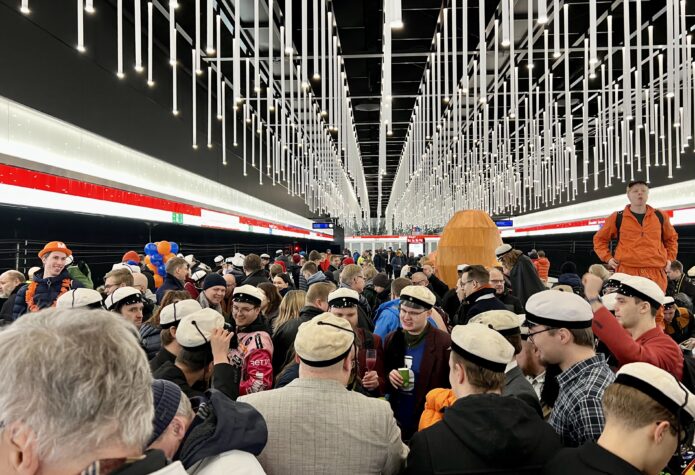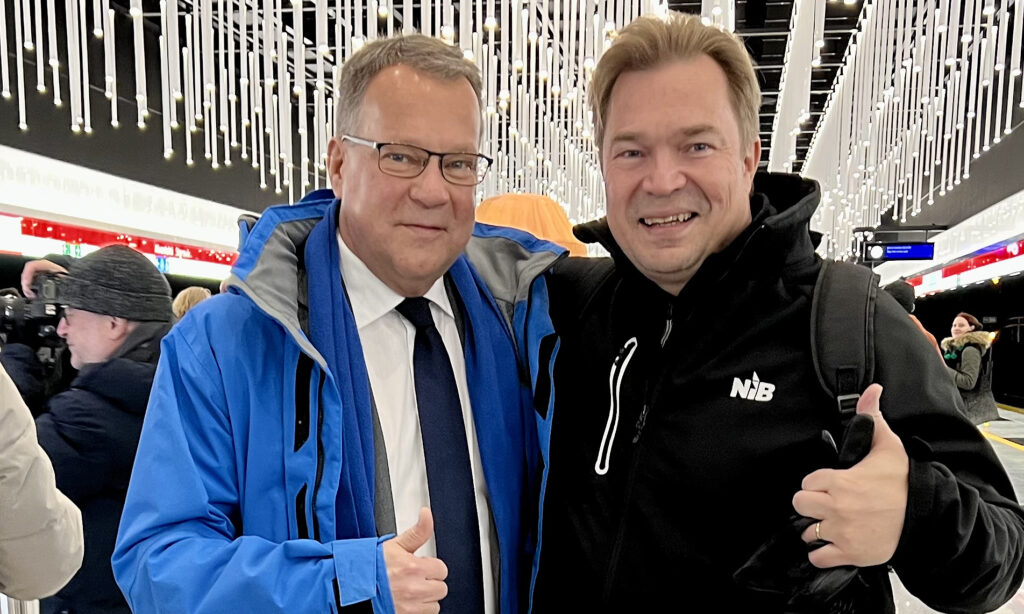First metro from Kivenlahti leaves the station

It’s 4:30 on a dark December morning, and I’m at the metro station in Kivenlahti in Espoo. It isn’t the most obvious time for a metro journey, especially on a Saturday, but the brand-new station is packed with people.
This time people aren’t just looking at their smartphones. They’re as cheerful and as talkative as Finns can be. It’s time to celebrate the new extension of the metro line.
After the VIPs have cut the ribbon, it’s time for the serious business.
The doors to the metro train open. Most lively travellers are the technology students. They are plenty and one can recognize them as they are wearing white caps and colourful overalls. I suspect that many of them have come to the metro ride directly from their student parties. Good old student life!
Seconds before the scheduled departure the students start to count: 3-2-1! The metro is not moving. The student choir stays cheerful now changing their lyrics to “Nonni, nonni…”, which in this case means a slight disappointment. However, in a couple of seconds the doors close and the students greet that with hurray.
It’s now 4:56, and the first metro train leaves the station on schedule. It seems a small step for the world but a huge one for Espoo, Helsinki’s neighbouring city.
The brand-new section is seven kilometres long, with five new stations: Finnoo, Kaitaa, Soukka, Espoonlahti and Kivenlahti. With this, the metro line from eastern Helsinki to Espoo is now complete.
The first section of the Helsinki metro was opened to the general public more than 40 years ago. At that time, the Finnish President Mauno Koivisto himself had the honour of cutting the ribbon.
After the latest expansion, the metro network in Helsinki and Espoo is now 43 kilometres long. The previous extension from Ruoholahti to Matinkylä connected Helsinki to Espoo. It was brought into use in 2017 with eight new stations. Today, about 60 million trips are made on the metro every year.
My employer, the Nordic Investment Bank, has paid out EUR 235 million to build the Länsimetro. Out of this amount, EUR 115 million has been allocated to the second phase. Other financiers include the European Investment Bank and Municipality Finance of Finland. We´re now seeing the results.

The new extension’s schedule and costs have been kept. Yet even when the metro has started operating, construction will continue around the stations. A completely new residential area will be created in Finnoo.
The Helsinki metro is in fact the most northern metro line in the world. In the autumn, before the snow arrives, the city is usually quite dark. In the 1970s, the designers wanted to bring the sun to the capital. That’s why they chose an untypical colour for the Nordics – orange – for the metro trains.
On this Saturday morning, Espoo is covered with snow. Luckily, although the metro is underground, and the travellers cannot enjoy the beautiful scenery, they can admire the new metro stations’ architecture.
When the train arrives in Finnoo, one can sense the area’s maritime atmosphere. The station displays the artwork “Haavekuvia” by Leena Nio. The images feature details of nature by the sea.
The trip from Kivenlahti to Matinkylä goes quickly. It takes about ten minutes, and another 20 minutes to the centre of Helsinki.
Today this journey is a novelty. Soon it will be part of the everyday life of the capital region’s citizens.

